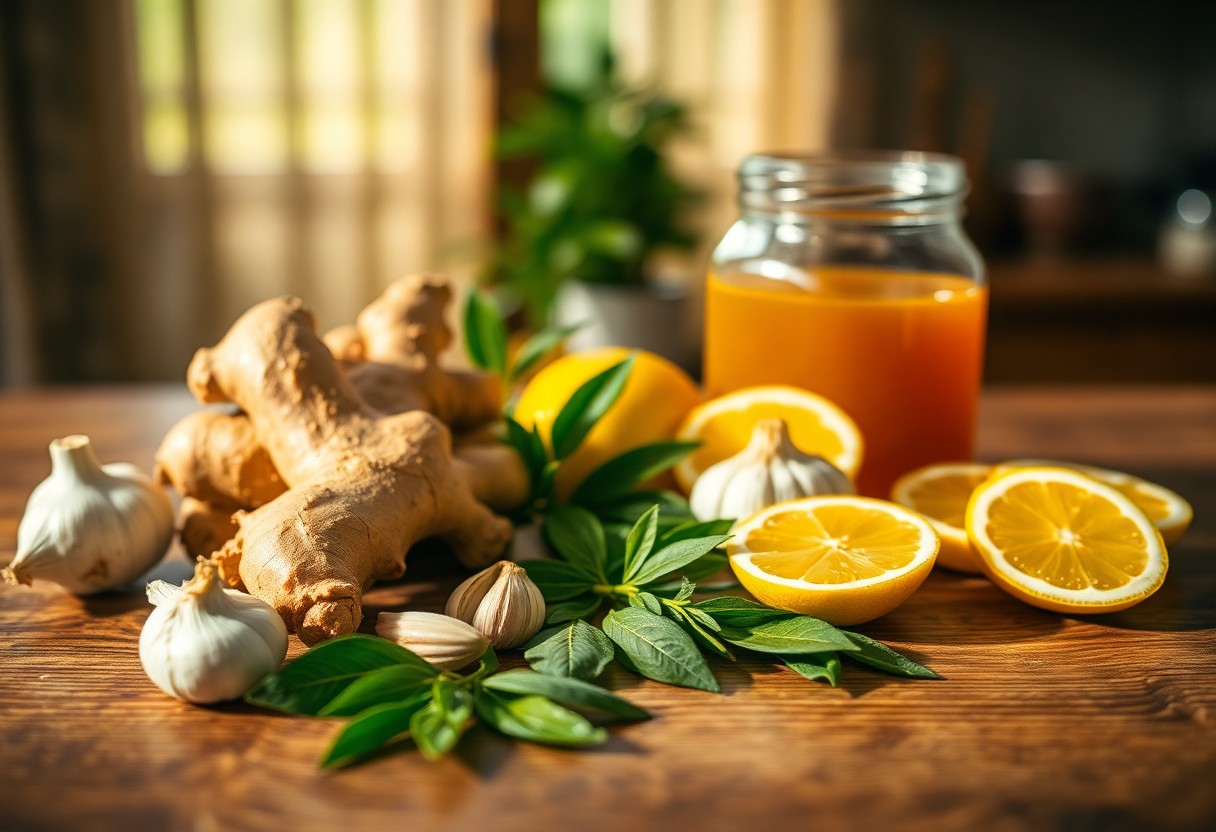Health & Society
Unlocking The Power Of Superfoods – Top 15 Natural Foods For Optimal Health

Over the years, health enthusiasts have discovered the remarkable benefits of superfoods, which are packed with crucial nutrients that can greatly enhance wellbeing. In this article, they will explore the top 15 natural foods recognized for their ability to combat diseases, boost energy levels, and promote overall health. By incorporating these powerhouses into their diets, individuals can unlock a more vibrant and healthier lifestyle, making informed choices about their nutrition and wellness.
Key Takeaways:
- Superfoods are nutrient-rich foods that provide numerous health benefits, including improved immunity and enhanced energy levels.
- Incorporating a variety of superfoods into your diet, such as berries, leafy greens, and nuts, can contribute to better overall health and wellness.
- Many superfoods are high in antioxidants, which help combat oxidative stress and reduce the risk of chronic diseases.
- Consuming superfoods regularly can help support weight management and improve digestion due to their high fiber content.
- By making small changes to your diet and adding superfoods, you can empower your health and vitality over time.
What Are Superfoods?
The term “superfoods” refers to nutrient-rich foods that provide remarkable health benefits. These foods are often packed with vitamins, minerals, antioxidants, and other crucial compounds that contribute to overall wellness. While there is no official definition governing what qualifies as a superfood, they are generally recognized for their high nutritional density and positive impacts on health.
Definition and Characteristics
Besides being nutrient-dense, superfoods often exhibit unique characteristics such as high antioxidant levels, anti-inflammatory properties, and beneficial phytochemicals. These attributes not only support bodily functions but also promote better health outcomes. Individuals seeking to improve their diet typically include these foods due to their overall effectiveness in enhancing well-being.
Nutritional Benefits
Superfoods offer a myriad of nutritional benefits that significantly enhance health and vitality. They often contain high levels of antioxidants, which help combat oxidative stress and reduce the risk of chronic diseases. Additionally, these foods are usually rich in crucial vitamins and minerals, which play a pivotal role in numerous biological processes. In fact, incorporating superfoods into one’s diet can lead to improved heart health, increased energy levels, and a boost in the immune system, making them a highly favorable choice for those committed to optimal health.
Top 15 Superfoods for Optimal Health
Clearly, the world of superfoods is vast, offering a plethora of options that can enhance overall well-being. By incorporating these nutrient-dense foods into their diet, individuals can harness the benefits of nature’s best offerings, contributing to a healthier lifestyle and improved vitality.
Berries
Optimal for health, berries are small but mighty superfoods packed with antioxidants and vitamins. They provide crucial phytochemicals that combat inflammation and support heart health. Rich in fiber and low in calories, they make excellent snacks or additions to smoothies, salads, and cereals.
Leafy Greens
Before venturing into the world of superfoods, leafy greens stand out for their nutrient density. They are abundant in vitamins A, C, K, and minerals like calcium and iron, all of which contribute to a robust immune system and overall health.
Superfoods such as spinach, kale, and Swiss chard are recognized for their detoxifying properties and their ability to support optimal digestion. These greens provide a wealth of antioxidants and are linked to lower risks of chronic diseases, including heart disease and certain cancers.
Nuts and Seeds
Around superfoods, nuts and seeds emerge as bite-sized powerhouses of healthy fats and protein. They are known for their heart-healthy properties and can improve satiety and energy levels when consumed as snacks or toppings in meals.
The diverse varieties of nuts, such as almonds, walnuts, and flaxseeds, offer a range of benefits including nutrients that support brain function, promote skin health, and assist in weight management. Their anti-inflammatory effects also contribute to overall wellness.
Whole Grains
An crucial component of a balanced diet, whole grains like quinoa, brown rice, and oats provide complex carbohydrates and dietary fiber. They help maintain steady energy levels and support digestive health.
Also, whole grains are not only a source of energy but also offer vital nutrients including B vitamins, iron, and magnesium. These nutrients work synergistically to improve metabolism, balance hormones, and reduce the risk of chronic diseases like type 2 diabetes and heart issues.
Fatty Fish
Against the common myths about seafood, fatty fish such as salmon, mackerel, and sardines are exceptionally rich in omega-3 fatty acids. These crucial fats are crucial for brain health and proper functioning of the heart.
In addition, regular consumption of fatty fish has been linked to a decreased risk of heart disease and stroke. The omega-3s found in these fish can help reduce inflammation and may even support mental health by combating symptoms of anxiety and depression.
Legumes
Greens such as beans, lentils, and chickpeas fall into the superfood category due to their high content of protein and fiber. These legumes are excellent plant-based protein sources that can replace meat in a diet.
It’s worth noting that legumes also contribute to improved gut health and can help manage blood sugar levels. Their low glycemic index makes them a suitable choice for those looking to maintain a healthy weight or manage diabetes effectively.
Fermented Foods
About the importance of gut health, fermented foods like yogurt, kimchi, and sauerkraut are vital as they contain probiotics. These beneficial bacteria play a significant role in maintaining a balanced gut microbiome.
For instance, incorporating fermented foods into one’s diet can enhance digestion, boost nutrient absorption, and even support the immune system. Additionally, they have been associated with mood improvement and overall mental well-being, making them a tasty and beneficial choice.
Cruciferous Vegetables
Superfoods such as broccoli, cauliflower, and Brussels sprouts belong to the cruciferous vegetable family. They are well-regarded for their high levels of vitamins, minerals, and unique compounds known to support health.
Nuts and seeds also play a supportive role when paired with cruciferous vegetables, amplifying their benefits. The combination provides a hearty dose of antioxidants and detoxifying elements that may help reduce the risk of cancer and other chronic diseases.
Avocado
Unlike many fruits, avocados are rich in healthy fats, particularly monounsaturated fat, which can support heart health. They are also loaded with fiber, vitamins, and minerals, making them a fantastic addition to any diet. Regular consumption of avocados may help reduce bad cholesterol levels and promote overall wellness, providing crucial nutrients that aid in nutrient absorption.
Sweet Potatoes
With their vibrant color and sweet flavor, sweet potatoes are a powerhouse of nutrition. Packed with antioxidants, they offer substantial amounts of vitamins A, C, and B6, as well as potassium and dietary fiber. Their low glycemic index makes sweet potatoes a smart choice for maintaining stable blood sugar levels, benefiting those looking to incorporate healthy carbohydrates into their meals.
Mushrooms
With numerous varieties available, mushrooms are not only delicious but also incredibly nutritious. They are low in calories, high in fiber, and provide a unique blend of vitamins and minerals, including B vitamins, selenium, and copper.
In addition, mushrooms contain bioactive compounds such as beta-glucans, which may enhance immune function. Certain types, like shiitake and maitake, have been studied for their potential anti-cancer properties. Furthermore, mushrooms can boost energy and support brain health through their high content of ergothioneine, an antioxidant linked to reducing oxidative stress.
Citrus Fruits
With their zesty flavors and vibrant colors, citrus fruits like oranges, lemons, and grapefruits are an excellent source of vitamin C. This crucial nutrient is vital for immune support and promotes healthy skin and connective tissues.
Indeed, citrus fruits also boast flavonoids that can help reduce inflammation and lower blood pressure. Their high water content aids in hydration, while their natural sweetness can satisfy cravings for sugary snacks, making them a versatile and healthy option for snacking and cooking.
Garlic
To harness the benefits of garlic, individuals should consider incorporating it into their daily meals. Garlic is known for its potential to enhance the immune system and has been used in various cultures for its medicinal properties throughout history.
Hence, garlic contains compounds such as allicin, which possess antimicrobial and anti-inflammatory properties. Studies suggest that regular garlic consumption may help lower blood pressure and improve cholesterol levels, contributing to better cardiovascular health.
Green Tea
Before drinking green tea, individuals should be aware of its numerous health benefits. Rich in antioxidants, particularly epigallocatechin gallate (EGCG), green tea has been linked to improved metabolism and enhanced fat burning.
Also, green tea may have a positive impact on brain function and may reduce the risk of neurodegenerative diseases. Regular consumption can support cardiovascular health and even promote longevity due to its high antioxidant content, which can combat harmful free radicals in the body.
Dark Chocolate
Around 70% cocoa content or higher dark chocolate provides a rich source of antioxidants known to improve heart health and enhance blood flow. It is a delightful treat that offers a range of health benefits.
Understanding the intricacies of dark chocolate reveals that it contains flavonoids, particularly catechins, which can lower blood pressure and improve cholesterol levels. Additionally, dark chocolate can elevate mood and provide a feeling of satisfaction, making it a valuable part of a balanced diet when consumed in moderation.
How to Incorporate Superfoods into Your Diet
Now that individuals are aware of the benefits of superfoods, they can easily integrate them into their daily meals for enhanced health. Simple adjustments include adding berries to their morning oatmeal, incorporating leafy greens in smoothies, and using quinoa as a base for salads. They can also explore meals that are rich in omega-3 fats by including fish like salmon or walnuts in their diet. With these incorporate strategies, every meal can be a step toward better health.
Meal Planning Tips
For those looking to maximize their nutrition, planning meals that feature superfoods can be effective. They can follow these helpful tips:
- Plan meals around seasonal produce.
- Incorporate at least one superfood in each meal.
- Batch cook dishes with quinoa or legumes.
- Keep a well-stocked pantry with nuts and seeds.
This will not only simplify meal prep but also ensure they are consuming a wide variety of nutrients.
Recipes Featuring Superfoods
About the integration of superfoods, several delicious recipes can elevate everyday meals to new nutritional heights. From vibrant smoothie bowls topped with chia seeds to hearty salads laden with kale, the possibilities are endless. Staying creative in the kitchen allows individuals to explore diverse flavor profiles while reaping the benefits of superfoods.
To create meals that highlight superfoods, they can experiment with combinations like sweet potato and black beans in a taco filling or use hemp seeds as a garnish for soups. In addition to enhancing taste, incorporating these nutrient-dense ingredients can lead to improved well-being. By engaging with various cooking methods, such as roasting or blending, they can easily introduce superfoods into their culinary repertoire, making healthy eating enjoyable and sustainable.
The Science Behind Superfoods
Keep in mind that the concept of superfoods is grounded in scientific research that explores the unique nutritional profiles and health benefits of these natural foods. Through rigorous studies, they aim to understand how specific nutrients and bioactive compounds can contribute to overall well-being, potentially reducing the risk of chronic diseases and enhancing vitality.
Research and Studies
To explore the claims surrounding superfoods, scientists have conducted numerous research studies that assess their impact on health. These studies analyze different food components, such as antioxidants, vitamins, and minerals, and their role in physiological processes. They yield valuable insights into how these nutrient-rich foods may support immune function, reduce inflammation, and promote longevity.
Potential Health Claims
Superfoods are often associated with numerous health claims, suggesting they can provide extraordinary benefits for the body. However, it is necessary that individuals critically evaluate these claims. At times, marketing may exaggerate benefits without sufficient scientific backing. While many superfoods, such as berries and leafy greens, are shown to boost immunity and provide potent antioxidants, others may lack definitive evidence. Individuals should focus on a balanced diet that incorporates a variety of these foods to achieve maximum health benefits.
Debunking Myths About Superfoods
For many people, superfoods evoke curiosity and confusion, leading to numerous myths that cloud their benefits. This chapter aims to clarify these misconceptions, helping individuals make informed choices about incorporating superfoods into their diets. Awareness of these myths allows them to navigate the overwhelming amount of information surrounding superfoods and focus on what truly contributes to their health and well-being.
Common Misconceptions
Superfoods often receive exaggerated reputations, leading to misconceptions such as the belief that they are a panacea or that consuming just one type can replace a balanced diet. While these nutrient-dense foods provide numerous health benefits, they are not magic solutions that negate the need for a varied and balanced intake of nutrients.
Clarifying Facts
Superfoods, while indeed nutrient-rich, should be viewed as a complement to a well-rounded diet rather than as standalone miracle cures. They can enhance overall wellness but do not replace the importance of other food groups. It is vital for individuals to incorporate a diverse range of foods to ensure they receive the full spectrum of nutrients necessary for optimal health.
Consequently, individuals should focus on integrating various superfoods into their diets alongside other whole foods, rather than overemphasizing a single source. This approach ensures a broader intake of important nutrients while also promoting overall health. Furthermore, relying solely on superfoods without a balanced diet can lead to nutritional deficiencies and undermine health goals. By understanding that superfoods are just one part of a larger nutritional puzzle, individuals can make choices that truly benefit their well-being.
Conclusion
Now that they have explored the benefits of superfoods, individuals can incorporate these top 15 natural foods into their diets for optimal health. By doing so, she can boost energy levels, support immune function, and enhance overall well-being. He may find that these nutrient-dense options not only elevate meals but also contribute to long-term health benefits. Ultimately, they can unlock the power of superfoods and make informed choices towards a healthier lifestyle.
FAQ
Q: What are superfoods and why are they important for health?
A: Superfoods are nutrient-dense foods that provide a range of health benefits, often packed with vitamins, minerals, antioxidants, and other important compounds. Including superfoods in your diet can enhance overall well-being, boost immunity, and help prevent various health issues, making them a valuable addition for optimal health.
Q: How do superfoods differ from regular foods?
A: Superfoods generally contain a higher concentration of nutrients compared to regular foods. While regular foods can provide basic nutrition, superfoods are often rich in antioxidants, healthy fats, and unique phytochemicals that contribute to better health outcomes. This potent nutritional profile is what sets them apart.
Q: Can superfoods help with specific health conditions?
A: Yes, many superfoods are linked to specific health benefits. For instance, berries like blueberries may improve heart health due to their high antioxidant content, while leafy greens like spinach can support bone health with their vitamin K levels. Incorporating varied superfoods into your diet can help manage or mitigate certain health conditions.
Q: How can I incorporate more superfoods into my daily diet?
A: You can easily include superfoods in your meals by adding them to smoothies, salads, and snacks. For example, you might blend kale and avocado into your smoothies, sprinkle chia seeds on yogurt, or make a salad featuring quinoa and various colorful veggies. Strategies such as planning meals around superfoods can enhance their intake seamlessly.
Q: Are there any risks associated with consuming superfoods?
A: Generally, superfoods are safe when consumed as part of a balanced diet. However, excessive consumption of certain superfoods can lead to unwanted side effects. For instance, too much kale can interfere with thyroid function in some individuals, while excessive intake of nuts can lead to weight gain. It’s important to consume these foods in moderation and consult with a healthcare provider if you have specific health concerns.
Health & Society
Natural Remedies For Common Ailments – Safe Solutions From Your Kitchen

Kitchen ingredients often hold the power to address common ailments effectively. He or she may find that simple items like ginger, honey, and garlic can provide safe solutions for conditions such as colds, sore throats, and digestive issues. They can explore the benefits of these natural remedies without the risks associated with pharmaceuticals. By utilizing what is readily available at home, individuals can enhance their well-being while fostering a holistic approach to health that embraces the wisdom of nature.
Key Takeaways:
- Natural remedies often utilize common kitchen ingredients such as honey, garlic, ginger, and turmeric for various health issues.
- Many kitchen items have anti-inflammatory and antibacterial properties, making them effective for addressing ailments like colds and digestive problems.
- Always consider potential allergies or interactions with medications when using natural remedies.
- Consistency in natural remedies is key; regular use can enhance their effectiveness over time.
- Consulting with a healthcare professional is advisable, especially for persistent health issues or before starting new treatments.
Understanding Common Ailments
To effectively manage health, one must first understand common ailments that many individuals face. These ailments can range from minor discomforts like headaches and colds to more severe conditions such as allergies and digestive issues. By recognizing symptoms and triggers, she can better prepare herself to address these issues with appropriate remedies.
Overview of Common Health Issues
Beside common colds and headaches, many people encounter ailments such as seasonal allergies, digestive disturbances, and skin irritations. These health issues often result from lifestyle choices, environmental factors, and stress, impacting daily life. Understanding the causes can empower individuals to seek effective solutions.
Importance of Natural Remedies
After recognizing personal health challenges, individuals may benefit from integrating natural remedies into their daily routines. These remedies often provide safe, effective alternatives to pharmaceuticals, addressing the root cause of ailments while minimizing side effects. They can also promote overall wellness and preventive care.
This approach offers a variety of benefits for those seeking to improve their health naturally. Many natural remedies found in the kitchen, such as ginger or garlic, possess anti-inflammatory and antioxidant properties that can help alleviate symptoms without harsh chemicals. Moreover, utilizing these remedies fosters a connection to nature and personal wellbeing, allowing individuals to rely on sustainable solutions while enhancing their health.
Kitchen Ingredients with Healing Properties
It is fascinating to explore how the ingredients found in one’s kitchen can serve as effective natural remedies. Many common items, including herbs, spices, fruits, and vegetables, possess unique healing properties that can address various ailments. By utilizing these ingredients, individuals may find safe and accessible solutions right at their fingertips.
Herbs and Spices
With a rich history of culinary and medicinal use, herbs and spices can offer numerous health benefits. Ingredients such as ginger can alleviate nausea, while turmeric boasts anti-inflammatory properties. Incorporating these potent elements into meals not only enhances flavor but also promotes overall well-being.
Fruits and Vegetables
At the heart of healthy cooking, fruits and vegetables are packed with imperative vitamins and minerals that support the immune system. They provide antioxidants that help combat oxidative stress, thus promoting better health. Common options like garlic have antibacterial properties, while spinach is rich in iron and nutrients.
Consequently, including a variety of fruits and vegetables in one’s diet can lead to significant health improvements. Citrus fruits, such as oranges and lemons, are high in vitamin C, supporting immune function. Other options like blueberries are rich in antioxidants, contributing to brain health and reducing the risk of chronic diseases. When prepared thoughtfully, these ingredients can transform meals into powerful health boosters.
Other Common Ingredients
Above all, household staples can also provide remarkable health benefits. Ingredients like honey are known for their soothing effects on the throat, while apple cider vinegar can aid digestion and support weight loss. These common items can easily be integrated into daily routines for improved health outcomes.
Spices play an integral role in enhancing both the flavor and nutritional profile of food. They can offer a plethora of health benefits, such as cinnamon‘s ability to help manage blood sugar levels. From soothing digestive issues with cumin to boosting immunity with oregano, it is clear that these kitchen imperatives can be powerful allies in promoting holistic wellness.
Home Remedies for Digestive Issues
After experiencing digestive issues, many people turn to their kitchens for natural remedies. Simple ingredients like ginger, peppermint, and yogurt can provide relief for various ailments. These remedies not only alleviate discomfort but also support overall digestive health, allowing individuals to find safe and effective solutions right at home.
Remedies for Indigestion
On particularly uncomfortable days, individuals often find relief from indigestion by consuming warm ginger tea or sipping on peppermint-infused water. Both ginger and peppermint are known for their ability to soothe the stomach lining and aid digestion. Additionally, incorporating small, frequent meals can help alleviate the pressure that contributes to indigestion.
Solutions for Constipation
For individuals struggling with constipation, a diet rich in fiber can make a significant difference. Foods such as oats, chia seeds, and leafy greens promote regular bowel movements and improve overall gut health. Staying hydrated is equally important, as water helps to soften stools and facilitate their passage.
But they should be cautious when self-treating constipation. Although fiber-rich foods are beneficial, an abrupt increase can lead to bloating and discomfort. She should ensure adequate hydration alongside fiber intake to maximize effectiveness. Including gentle laxatives like prunes or chia seeds can also be beneficial. Balancing these remedies ensures a smooth digestive process while avoiding potential complications.
Addressing Cold and Flu Symptoms
Once again, she finds that natural solutions can effectively combat the discomfort of cold and flu symptoms. Among her kitchen staples, items like honey, ginger, and garlic can provide relief from congestion and promote overall wellness. By harnessing these ingredients, she can ease most common ailments and support her immune system during the cold and flu season.
Natural Treatments for Cough
Behind every persistent cough, there may be an opportunity to soothe with nature’s ingredients. She can create simple cough syrups using honey and lemon, both known for their soothing properties. These remedies provide natural comfort without the harsh side effects of over-the-counter medications.
Remedies for Sore Throat
After experiencing a sore throat, she can turn to easy-to-find kitchen remedies for relief. Options such as warm salt water gargles, honey with warm tea, or even soothing lozenges made from ginger can help reduce inflammation and provide comfort.
Plus, she should consider using warm salt water gargles, as this remedy can effectively alleviate soreness and is made from simple ingredients. He can mix one teaspoon of salt into a glass of warm water to create a solution that reduces swelling and keeps the throat moist. Alternatively, a mix of honey and lemon mixed into warm water can provide both hydration and nourishment. They find that these natural treatments not only comfort but also promote quick recovery from a sore throat, allowing her to return to daily activities sooner.
Natural Pain Relief Options
Not all pain relief solutions need to come in a bottle. Many individuals turn to natural remedies found directly in their kitchens, offering effective and safe treatments for common aches and pains. Options such as important oils and herbal teas provide alternative ways to alleviate discomfort without the side effects often associated with over-the-counter medications.
Using Essential Oils
Across various cultures, important oils have been utilized for their therapeutic properties. These oils, extracted from plants, can be applied topically or inhaled to help ease pain. For instance, he or she might consider using lavender for headaches or eucalyptus for muscle soreness—each offering a unique approach to natural pain management.
Herbal Teas for Pain Management
Below are some herbal teas that may assist in alleviating pain. Chamomile can soothe headaches, while ginger tea is known for its anti-inflammatory properties, often helping with joint pain. Similarly, peppermint tea can help calm digestive discomfort. Each option provides a gentle approach to pain relief.
Options for herbal teas extend beyond basic infusions, as they can be tailored to individual needs. For example, turmeric tea is renowned for its anti-inflammatory benefits, making it suitable for those suffering from chronic pain conditions. Additionally, devil’s claw tea may assist in reducing arthritis symptoms. It’s important for him or her to consult a healthcare professional to ensure these natural remedies complement their overall health strategy safely.
Skin Care Solutions
All natural remedies can provide effective solutions for various skin concerns using ingredients readily available in one’s kitchen. These remedies not only promote healing but also enhance overall skin health without the potential side effects of commercial products. From soothing irritations to treating breakouts, natural solutions are often gentler and kinder to the skin, making them a preferred choice for many.
Homemade Treatments for Acne
Among the most common skin ailments, acne can be treated with natural ingredients found in the kitchen. For instance, a paste made from honey and cinnamon can help reduce inflammation and kill acne-causing bacteria, while applying diluted tea tree oil can serve as a potent antimicrobial treatment. These natural remedies not only target the root causes but may also minimize scarring, offering a holistic approach to skin care.
Remedies for Minor Burns and Cuts
Any minor burn or cut can be soothed effectively with natural home remedies. Ingredients like aloe vera, honey, and coconut oil possess natural healing properties that can aid in recovery while reducing the risk of infection.
To care for minor burns and cuts, using aloe vera can greatly benefit the skin due to its anti-inflammatory properties, which help reduce redness and irritation. Honey serves as a natural antibacterial agent, promoting healing without the need for chemical ointments. Applying a thin layer of coconut oil can also moisturize the skin, creating a barrier against further irritation. For optimal results, they should ensure the area is clean before applying these remedies. In severe cases, it is advised to seek professional medical attention.
To wrap up
Conclusively, individuals seeking natural remedies for common ailments can find effective solutions right in their kitchens. They can utilize ingredients like ginger, honey, and garlic to alleviate various health issues without the adverse effects often associated with pharmaceuticals. By embracing these safe alternatives, they enhance their well-being while reconnecting with traditional practices. With proper knowledge and application, one can harness the healing power of everyday foods and promote a healthier lifestyle.
FAQ
Q: What are some common kitchen ingredients that can be used as natural remedies?
A: Many kitchen ingredients can serve as effective natural remedies for various ailments. For instance, honey is known for its antibacterial properties and can soothe sore throats. Ginger has anti-inflammatory effects and may help with nausea. Garlic is often used for its immune-boosting capabilities, while turmeric contains curcumin, which is beneficial for reducing inflammation. Other ingredients like chamomile, cayenne pepper, and apple cider vinegar also have healing properties that can be harnessed at home.
Q: How can I use honey to relieve a sore throat?
A: Honey can be very effective in soothing a sore throat due to its natural antibacterial properties. To use honey for a sore throat, mix 1-2 tablespoons of honey in a warm glass of water or herbal tea. Adding lemon can enhance the effect, as it provides vitamin C and helps to thin mucus. This mixture can be consumed several times a day for relief.
Q: What home remedies can I try for indigestion?
A: For indigestion, several remedies from your kitchen may provide relief. Peppermint tea can help relax the digestive tract, while ginger, either as a tea or raw slices, may reduce nausea and improve digestion. Eating a banana can help neutralize stomach acid. Additionally, a tablespoon of apple cider vinegar mixed in a glass of water before meals may aid in digestion. It’s important to listen to your body and determine which remedy works best for you.
Q: Are there natural solutions for headaches using kitchen items?
A: Yes, several kitchen items can help alleviate headaches. Peppermint oil, when diluted with a carrier oil, can be applied to the temples for a cooling effect that alleviates headache pain. Ginger tea can also help reduce the severity of migraines. Staying hydrated with water or herbal teas is equally important, and some individuals find relief by consuming foods high in magnesium, such as nuts or spinach, as these can help reduce tension headaches.
Q: How can I utilize turmeric for inflammation relief?
A: Turmeric is renowned for its anti-inflammatory properties, mainly due to the active compound curcumin. To utilize turmeric for inflammation relief, it can be incorporated into meals as a spice or made into a tea. To prepare turmeric tea, simmer a teaspoon of turmeric powder in water or milk, add black pepper to enhance absorption, and sweeten with honey if desired. Consuming this daily can help manage inflammation over time, but it’s beneficial to consult with a healthcare provider for proper guidance and dosage.
Health & Society
The Benefits Of A Plant-Based Diet – How Going Green Can Transform Your Health

There’s a growing movement towards a plant-based diet, and many are discovering how this lifestyle choice can lead to significant changes in their health. By opting for fruits, vegetables, whole grains, and legumes, individuals often experience enhanced energy levels and better weight management. Moreover, studies suggest that a plant-based diet may reduce the risk of chronic diseases such as heart disease and diabetes. As they explore this green journey, people find themselves not only improving their well-being but also contributing positively to the environment.
Key Takeaways:
- A plant-based diet can significantly lower the risk of chronic diseases such as heart disease, diabetes, and certain cancers.
- Transitioning to a plant-based diet promotes weight management and can aid in weight loss due to its typically lower calorie density.
- Incorporating more plant foods enhances nutritional intake, providing crucial vitamins, minerals, and antioxidants that support overall health.
- A plant-based lifestyle can improve digestive health by increasing fiber consumption, which promotes gut health and regularity.
- This diet contributes to environmental sustainability, reducing carbon footprints and the use of natural resources compared to animal-based diets.
Understanding Plant-Based Diets
A plant-based diet focuses on consuming foods derived from plants, including fruits, vegetables, grains, nuts, and seeds. This dietary approach emphasizes whole, minimally processed foods while reducing or eliminating animal products. By adopting such a lifestyle, individuals can experience numerous health benefits, including improved nutrition, weight management, and enhanced well-being.
Definition and Principles
Principles of a plant-based diet center around prioritizing plant-derived foods, minimizing animal products, and incorporating a variety of whole foods. It supports environmental sustainability and promotes health by encouraging nutrient-dense choices. By steering clear of processed foods and refined sugars, individuals can cultivate a healthier eating pattern.
Types of Plant-Based Diets
Around the world, there are various types of plant-based diets that cater to different preferences and lifestyles. Below is a table that outlines the most common types of plant-based diets along with their key features:
| Type | Description |
| Vegetarian | Excludes meat, poultry, and fish |
| Vegan | Excludes all animal products, including dairy and eggs |
| Pescatarian | Includes fish and seafood but excludes meat and poultry |
| Flexitarian | Primarily plant-based but occasionally includes meat |
| Raw Vegan | Excludes all animal products and is composed of uncooked foods |
Those exploring plant-based diets benefit immensely from understanding these categories. Each type offers flexibility and adaptability, allowing for a personalized approach that aligns with individual goals and preferences. Thou shall choose the diet that resonates best with their lifestyle and health aspirations.
Also, individuals might find that the following categories of plant-based diets fit their needs:
| Type | Benefits |
| Vegetarian | Improved heart health, lower cholesterol |
| Vegan | Reduces risk of chronic diseases, weight loss |
| Pescatarian | Inclusion of omega-3 fatty acids, balanced nutrition |
| Flexitarian | Provides dietary flexibility, encourages mindful eating |
| Raw Vegan | Packed with enzymes, rich in vitamins |
In their journey towards better health, individuals can find that embracing a plant-based diet not only elevates their nutrition but also contributes significantly to their overall wellness. Thou shall explore and experiment with these various types to discover the best fit for their lifestyle.
Health Benefits of a Plant-Based Diet
Assuming an individual adopts a plant-based diet, they may experience a range of health benefits that can enhance their overall well-being. This dietary choice is often linked to lower rates of chronic diseases, increased energy levels, and improved digestion. By focusing on whole foods, they can enrich their nutrient intake, support their immune system, and foster a healthier lifestyle.
Improved Heart Health
Below the surface, a plant-based diet plays a significant role in improving heart health. By consuming more fruits, vegetables, legumes, and whole grains, individuals can lower their cholesterol levels and reduce blood pressure, significantly decreasing the risk of heart disease.
Weight Management and Metabolism
Weight management becomes more attainable with a plant-based diet. This dietary approach emphasizes nutrient-dense, low-calorie foods that aid in maintaining a healthy weight. Individuals find it easier to manage their cravings and maintain a balanced metabolism, which leads to effective weight control.
Diet plays a pivotal role in maintaining a healthy weight and optimizing metabolism. *By incorporating high-fiber foods such as fruits, vegetables, and legumes, they can feel full with fewer calories, which supports weight loss efforts.* Additionally, a plant-based diet may enhance metabolic health, as it is rich in antioxidants and phytochemicals that support efficient energy use. Overall, embracing this lifestyle encourages sustainable weight management while promoting a vibrant, energetic life.
Nutritional Aspects
Your health can greatly benefit from the rich array of nutrients found in a plant-based diet. By focusing on whole foods such as fruits, vegetables, grains, nuts, and seeds, individuals can obtain vitamins, minerals, and antioxidants important for overall wellbeing. This diet often helps reduce the risk of chronic diseases while promoting a healthy weight and improved energy levels.
Essential Nutrients in Plant Foods
Nutrients such as protein, iron, calcium, and omega-3 fatty acids can be adequately sourced from plant foods. Legumes, nuts, and whole grains provide important amino acids, while dark leafy greens, fortified plant milks, and seeds offer vital minerals. A well-balanced plant-based diet ensures that individuals receive the vital nutrients necessary for health without the negative impacts associated with animal products.
Common Myths and Misconceptions
An array of misconceptions surrounds plant-based diets. Many believe that they are deprived of protein or important vitamins, leading to a fear of nutrient deficiencies. Others assume that maintaining a plant-based diet is overly difficult and expensive, which discourages individuals from making the switch.
And this apprehension is often fueled by misinformation prevalent in society. For instance, the idea that plant-based diets lack adequate protein is misleading; in fact, many plant foods are rich in protein, but people should pay attention to the variety in their diet to ensure they receive all necessary amino acids. Moreover, while there may be an initial investment in whole plant foods, they can often be more cost-effective in the long term compared to processed foods and animal products. A plant-based lifestyle can therefore be both sustainable and beneficial, dispelling these damaging myths.
Environmental Impact
After adopting a plant-based diet, individuals can significantly reduce their environmental footprint. This dietary shift not only helps combat climate change by lowering greenhouse gas emissions but also promotes biodiversity and protects ecosystems. By moving away from animal agriculture, they contribute to a more sustainable planet, lessening the demand for environmentally damaging farming practices.
Sustainability and Resource Conservation
Sustainability is at the core of a plant-based diet, as it requires fewer natural resources compared to meat production. By consuming plants, individuals support land conservation and reduce water usage, helping preserve vital ecosystems for future generations. This mindful approach encourages efficient use of agricultural resources and minimizes waste, aligning with broader goals for a healthier planet.
Reducing Carbon Footprint
An integral benefit of a plant-based diet is its ability to greatly reduce one’s carbon footprint. By choosing plant foods over animal products, individuals can decrease their greenhouse gas emissions, as meat production is one of the leading contributors to global warming. The cultivation of crops for plant-based diets typically results in lower emissions, thus promoting a more sustainable future.
The shift to a plant-based diet not only enhances personal health but also has a profound effect on the environment. The food industry is responsible for approximately 25% of global greenhouse gas emissions, with livestock production being a significant factor. Moreover, they can lower their carbon footprint by nearly 50% by eliminating animal products from their meals. In doing so, they are actively contributing to a reduction in fossil fuel consumption and GHG emissions, leading to a healthier climate for everyone.
Transitioning to a Plant-Based Diet
All individuals considering a shift to a plant-based diet will find that the transition can be both rewarding and manageable. Embracing this lifestyle requires a thoughtful approach, often involving gradual changes to their current eating habits. By incorporating more fruits, vegetables, whole grains, and legumes, one can enhance their health and discover new culinary delights.
Tips for New Adopters
By following a few straightforward strategies, new adopters can ease into a plant-based diet. They may consider:
- Start with simple, familiar vegan recipes
- Gradually replace animal products with plant-based options
- Explore local markets for fresh produce
- Join online communities for support and inspiration
Any approach that fosters enthusiasm and curiosity can significantly enhance the transition experience.
Meal Planning and Preparation
Transitioning to a plant-based diet can be greatly facilitated by effective meal planning and preparation. She should ensure her meals are balanced, featuring a variety of nutrient-dense foods that provide crucial vitamins and minerals. This process may include creating a weekly menu, selecting recipes that utilize seasonal ingredients, and prepping meals in advance. By doing so, she can avoid the pitfalls of last-minute decisions that often lead to unhealthy choices. The key is to stay organized, keep the pantry stocked with whole foods, and experiment with different cuisines. This organized approach allows for a smoother transition and can help them discover enjoyable plant-based meals that align with their health goals.
Personal Success Stories
Keep in mind that transitioning to a plant-based diet can lead to remarkable personal success stories. Many individuals have experienced life-changing transformations, finding not only physical health improvements but also enhanced mental well-being. These stories highlight the diverse ways a plant-based lifestyle can empower individuals to take control of their health and vitality.
Health Transformations
With a plant-based diet, they have witnessed significant health transformations. Weight loss, improved energy levels, and reduced risks of chronic diseases are just a few benefits often reported. Many individuals have successfully reversed conditions such as heart disease and diabetes, showcasing how a dedicated shift in eating habits can lead to profound improvements in one’s overall health.
Testimonials from Individuals
At the core of these success stories are heartfelt testimonials from individuals who embraced plant-based eating. Each account reveals unique experiences and challenges, as well as the incredible benefits they have encountered on their journeys. Their stories serve as inspiration for others considering this lifestyle change.
The rich tapestry of testimonials demonstrates that they have experienced more than just weight loss on a plant-based diet; they have also noted enhanced mental clarity, increased energy, and a newfound relationship with food that emphasizes well-being. She describes her journey of overcoming lifelong digestive issues, while he shares how reducing his cholesterol levels has profoundly impacted his confidence and overall health. They highlight the importance of embracing whole foods, showing that the shift often leads to a renewed zest for life and a commitment to making healthier choices.
Summing up
Taking this into account, adopting a plant-based diet can significantly enhance individual health and well-being. They benefit from increased energy levels, improved digestion, and a lower risk of chronic diseases. Furthermore, he or she may experience enhanced mental clarity and emotional stability, contributing to a more balanced lifestyle. By making more environmentally conscious food choices, they also support sustainable practices that benefit the planet. Overall, transitioning to a plant-based diet symbolizes a commitment to personal health and global sustainability.
FAQ
Q: What are the main health benefits of adopting a plant-based diet?
A: A plant-based diet is associated with numerous health benefits, including improved heart health, lower risk of chronic diseases, weight management, and enhanced digestion. By emphasizing fruits, vegetables, whole grains, legumes, and nuts, individuals can reduce their intake of saturated fats and cholesterol, leading to healthier cholesterol levels and blood pressure. Additionally, plant-based diets are often rich in fiber, which supports healthy digestion and can aid in weight loss by promoting satiety.
Q: Can a plant-based diet provide all the necessary nutrients?
A: Yes, a well-planned plant-based diet can provide all imperative nutrients. To ensure adequate intake of protein, iron, calcium, omega-3 fatty acids, and vitamin B12, it’s important to include a variety of plant foods. Protein can be found in legumes, tofu, tempeh, and whole grains, while iron can be obtained from lentils, chickpeas, and spinach. For vitamin B12, fortified foods or supplements are recommended, as it is primarily found in animal products.
Q: How does a plant-based diet affect energy levels?
A: Many individuals report increased energy levels after adopting a plant-based diet. This boost in energy can be attributed to the consumption of whole, nutrient-dense foods that are high in complex carbohydrates, fiber, and antioxidants. These foods provide a steady source of energy and help stabilize blood sugar levels, reducing energy crashes often associated with processed foods high in refined sugars and fats.
Q: Is a plant-based diet suitable for all age groups?
A: Yes, a plant-based diet can be suitable for individuals of all ages when appropriately planned. Children, adults, and seniors can all benefit from the wide array of nutrients found in plant-based foods. However, it’s important for parents to ensure that children receive all necessary nutrients for growth and development. Tailoring a plant-based diet to meet individual nutritional needs can help accommodate varying age-related dietary requirements.
Q: What are some practical tips for transitioning to a plant-based diet?
A: Transitioning to a plant-based diet can be made easier by following a few practical tips: Start by incorporating more fruits and vegetables into your meals; gradually replace animal-based proteins with plant-based alternatives; explore new recipes to keep meals exciting; and consider meal prepping to ensure you have healthy options readily available. Additionally, seeking support from online communities or local groups can provide motivation and valuable resources during the transition.
Health & Society
Exploring The Healing Power Of Essential Oils – A Beginner’s Guide

You may be surprised to learn that crucial oils offer a wealth of therapeutic benefits and can play a significant role in enhancing overall well-being. In this informative guide, he or she will discover how these potent extracts can effectively address various health concerns, from stress relief to improved sleep quality. It is vital to understand that while crucial oils can be beneficial, proper usage and safety guidelines should always be adhered to. By delving into the world of crucial oils, they will uncover the secrets to unlocking nature’s healing power in their everyday lives.
Key Takeaways:
- Essential oils can be used for a variety of therapeutic purposes, including stress relief, improved sleep, and enhanced mood.
- Understanding the different extraction methods and types of crucial oils is important for selecting high-quality products.
- Safety is key—always dilute crucial oils with a carrier oil before topical application and conduct patch tests to avoid skin reactions.
- Different oils have unique properties; for example, lavender is known for relaxation, while tea tree oil is often used for its antibacterial effects.
- Aromatherapy can be effectively practiced at home using diffusers, inhalation techniques, or incorporating oils into baths and massages.
Understanding Essential Oils
Before venturing into the world of aromatherapy, it is vital to have a clear understanding of what vital oils are and how they can enhance well-being. These concentrated extracts from plants contain potent aromatic compounds that provide various therapeutic benefits. Each vital oil possesses unique properties, making them versatile allies in promoting emotional and physical health.
What are Essential Oils?
By definition, vital oils are natural, highly concentrated plant extracts that capture the distinctive fragrance and medicinal properties of the botanicals from which they originate. They are used for various applications, including aromatherapy, topical treatments, and more.
How Essential Oils are Extracted
At their core, vital oils are derived through various extraction methods, primarily steam distillation and cold pressing. These processes allow the preservation of the powerful compounds within the plant materials, ensuring the purity of the final product.
In fact, steam distillation involves passing steam through plant materials to extract the vital oils, while cold pressing is primarily used for citrus fruits, where the outer peel is mechanically pressed to release the oils. It’s important to note that not all extraction methods yield the same quality; methods like solvent extraction can leave harmful residues, making it vital to source oils that are 100% pure. Moreover, understanding the extraction process is vital since some methods may compromise the integrity of the oil, impacting its overall therapeutic properties and effectiveness.
The Science Behind Aromatherapy
Assuming he or she is curious about the fundamentals of aromatherapy, it is crucial to understand the interaction between crucial oils and the human body. Aromatherapy harnesses concentrated plant extracts to enhance physical and emotional well-being. Scientific studies have indicated that these oils can affect the limbic system, which governs emotions and memories, thereby influencing mood and health.
How Essential Oils Affect the Brain
Against common misconceptions, crucial oils do more than just smell pleasant; they can elicit profound responses in the brain. Research has shown that when inhaled, these oils interact with the olfactory system, sending signals directly to the limbic system, which is responsible for emotional regulation and memory. This connection explains why specific scents can trigger powerful emotional or physical responses.
The Role of Scent in Healing
Brain scientists have discovered that scents can evoke strong emotional reactions and memories, making them an crucial tool in holistic healing. At a physiological level, inhaling certain crucial oils can lead to decreased cortisol levels, promoting relaxation and alleviating stress. Moreover, particular scents, such as lavender and chamomile, are known to enhance sleep quality and reduce anxiety. This connection between smell and emotional well-being highlights the importance of incorporating crucial oils into daily routines as a natural way to support mental health and create a calming environment.
Common Essential Oils and Their Uses
Unlike synthetic fragrances, vital oils offer a variety of therapeutic benefits derived from natural plant extracts. Each oil possesses unique properties that can support physical and emotional well-being. For beginners, getting acquainted with common vital oils like lavender, peppermint, and eucalyptus is a great starting point to explore aromatherapy and its myriad applications.
Lavender for Relaxation
Around bedtime, many individuals turn to lavender oil for its highly regarded calming effects. This vital oil is often used in diffusers or added to nighttime routines, as it promotes tranquility and restful sleep. Its soothing aroma can ease anxiety and stress, making it an ideal companion for relaxation practices.
Peppermint for Energy
With its invigorating scent, peppermint oil is popular among those seeking a natural energy boost. This vital oil is often diffused or applied topically to enhance focus and alertness, helping to combat feelings of fatigue. Its refreshing properties make it a go-to oil for anyone needing a pick-me-up during the day.
In addition to providing an energy boost, peppermint oil has various therapeutic properties. It is known to promote mental clarity and concentration, making it beneficial for those needing to stay focused. Moreover, the oil can aid in alleviating headaches and providing relief from sinus congestion. However, users should be cautious as peppermint oil can be irritating to sensitive skin and needs to be diluted before topical application. By harnessing the power of peppermint oil, individuals can enhance their productivity and vitality safely.
How to Use Essential Oils Safely
Keep in mind that necessary oils are potent substances that require careful handling. To ensure safe usage, individuals should always perform patch tests before applying new oils directly to the skin, and they should seek guidance on safe dosage and dilution practices. By prioritizing safety, users will minimize the risk of adverse reactions and enhance their overall experience with necessary oils.
Dilution and Application Methods
Across various application methods, necessary oils should be diluted properly to reduce potential skin irritation. Common carrier oils such as jojoba, sweet almond, or coconut oil can effectively serve this purpose. Standard dilution ratios recommend mixing one to three drops of necessary oil with a teaspoon of carrier oil, depending on the intended use, which allows for safe topical application or use in aromatherapy diffusers.
Potential Allergies and Side Effects
Dilution is necessary, but individuals should also be aware of potential allergies and side effects that may arise from necessary oils. Some may experience skin irritations, allergic reactions, or sensitivity when using specific oils, making patch testing vital. Seeking advice from a healthcare professional before beginning any necessary oil regimen can help he, she, or they avoid any negative experiences.
Understanding the risks associated with necessary oils is key to safe usage. Individuals may experience a range of allergic reactions, from mild skin irritations to more severe effects like respiratory distress in sensitive individuals. It’s necessary for they to recognize common allergens such as eucalyptus and lavender, which may trigger negative responses. Additionally, certain necessary oils are photosensitive, especially citrus oils, increasing the risk of sunburn when applied before sun exposure. For a positive and safe experience, a small group should always consult a healthcare provider and monitor their reactions closely when incorporating new oils into their routine.
Creating Your Essential Oil Blends
Many enthusiasts find that creating their own imperative oil blends allows for a personalized experience that caters to individual needs. By experimenting with various combinations, they can explore unique scents and therapeutic properties to enhance their well-being. This process not only promotes creativity but also empowers them to discover the perfect blend that resonates with their preferences.
Choosing the Right Oils
Across the vast array of imperative oils available, selecting the right ones for a blend can be overwhelming. To navigate this, individuals often consider the desired benefits, such as relaxation or invigorating effects, while also taking into account their personal scent preferences. Researching each oil’s properties enables them to create harmonious and effective combinations.
Blending Techniques
Among the several methods to combine imperative oils, understanding blending techniques can significantly enhance the blending experience. Simple methods like the drop-by-drop technique allows for precise control while more advanced techniques like layering and diluting oils offer various depth and complexity to the blends.
Oils can be combined through a few straightforward techniques. For instance, the drop-by-drop method involves adding single drops of each imperative oil to a blending bottle, which can then be adjusted as needed. Layering involves first adding heavier imperative oils followed by lighter ones, ensuring a balanced aroma. Furthermore, using a carrier oil is imperative to dilute stronger oils, preventing any potential skin irritation. By considering dilution ratios and allowing blends to sit for a day, they ensure that the final product is well-rounded and harmonious.
Incorporating Essential Oils into Daily Life
Once again, vital oils can be seamlessly integrated into everyday routines, enhancing well-being in various facets of life. Whether for relaxation, stimulation, or personal care, incorporating these potent oils offers numerous benefits. She can add a few drops to her laundry, he can use them in his skincare regimen, or they can simply enjoy the aromatic experience during daily tasks. With customization possibilities, vital oils can adapt to individual preferences and lifestyles, making them a versatile addition to living a holistic life.
Diffusers and Aromatherapy
Oils can be effectively dispersed into the air using diffusers, creating an enchanting atmosphere that promotes mental clarity and emotional balance. Essential oils like lavender and eucalyptus are popular choices as they can evoke calmness and boost respiratory health. By diffusing these oils throughout the day, he, she, or they can experience their therapeutic effects while enjoying the delightful scents that elevate any space.
Bath and Body Applications
Among the various ways to incorporate vital oils, bath and body applications stand out as particularly enjoyable and beneficial. Essential oils can transform a simple bath into a rejuvenating experience, with options ranging from soothing lavender for relaxation to invigorating orange for energy. They can also be added to lotions or carrier oils for massages, enhancing skin health and providing therapeutic effects that help minimize stress and tension.
Another appealing method is the addition of vital oils to bath products, where the right combination can create a soothing environment. Using oils like tea tree for its antibacterial properties or chamomile to calm the mind enhances the bath experience. It’s vital for them to use a carrier oil, such as coconut or jojoba, to prevent skin irritation, as some oils can be strongly concentrated. By blending these oils with their favorite moisturizers, they can enjoy positively transformative effects on the skin while indulging in delightful scents that promote mental well-being.
Conclusion
Following this beginner’s guide, individuals can appreciate the remarkable healing properties of important oils. By understanding their various applications and benefits, he or she can harness these natural remedies to enhance well-being. Additionally, they may discover how important oils can complement their health routines, offering support for physical and emotional challenges alike. As they explore the world of aromatherapy, he, she, and they will be equipped to make informed choices that resonate with their personal wellness journeys.
FAQ
Q: What are necessary oils and how are they extracted?
A: Essential oils are concentrated plant extracts that capture the natural fragrance and beneficial properties of the plant. They are typically extracted through methods such as steam distillation, cold pressing, or solvent extraction. Each method varies based on the plant type and desired oil quality. This process ensures that the essence of the plant is encapsulated in the oil, allowing for various therapeutic benefits.
Q: What are the common uses of necessary oils in healing?
A: Essential oils can be utilized in various ways for healing purposes, including aromatherapy, topical application, and even ingestion in some cases. They can be used to alleviate stress and anxiety, promote better sleep, boost mood, enhance immune function, and aid in pain relief. Additionally, some oils have antiseptic properties, making them useful in skincare and wound care.
Q: Are there any safety precautions to take when using necessary oils?
A: Yes, it is important to follow safety guidelines when using necessary oils. Always dilute necessary oils with a carrier oil, such as coconut or jojoba oil, before applying them to the skin. Conduct a patch test to check for any skin sensitivities. Some oils are not recommended for children, pregnant women, or individuals with certain medical conditions, so consulting with a healthcare professional is advisable prior to use.
Q: How can I incorporate necessary oils into my daily routine?
A: Incorporating necessary oils into your daily routine can be simple and enjoyable. You can use an necessary oil diffuser to fill your space with uplifting scents or add a few drops of your favorite oil to your bath for a relaxing soak. Using necessary oils in homemade cleaning products or skin care routines is another great way to reap their benefits. Additionally, you can create personalized roller blends for on-the-go application to support emotional wellness.
Q: Where can I purchase high-quality necessary oils?
A: High-quality necessary oils can be purchased from various sources, including health food stores, specialty shops, and online retailers. It is necessary to look for brands that provide pure, therapeutic-grade oils without synthetic additives. Reading reviews, checking for third-party testing, and ensuring the oils are sourced responsibly will help you find reputable products to use in your wellness journey.
-

 Sports5 days ago
Sports5 days agoEdison Callejas dominates the third stage of the Giro d'Abruzzo
-

 EU & the World5 days ago
EU & the World5 days ago‘Ginny & Georgia’ Season 3: Trailer, Release Date, Cast & More Details
-

 EU & the World3 days ago
EU & the World3 days agoIs Bobby Coming Back to ‘911’? Find Out if Peter Krause Will Return
-

 EU & the World5 days ago
EU & the World5 days ago‘Fantastic Four’ 2025: ‘First Steps’ Trailer, Release Date, Cast & More
-

 EU & the World4 days ago
EU & the World4 days agoFSU Shooter 2025: Who Is the Florida State Shooting Suspect Phoenix Ikner?
-

 EU & the World3 days ago
EU & the World3 days agoWrestleMania 41 Start Time: When Does it Begin?
-

 EU & the World4 days ago
EU & the World4 days agoFlorida State University Shooting: Updates on the FSU Situation
-

 Sports5 days ago
Sports5 days agoFormula 1, Verstappen towards Red Bull farewell? Aston Martin attempts the coup of the decade





















